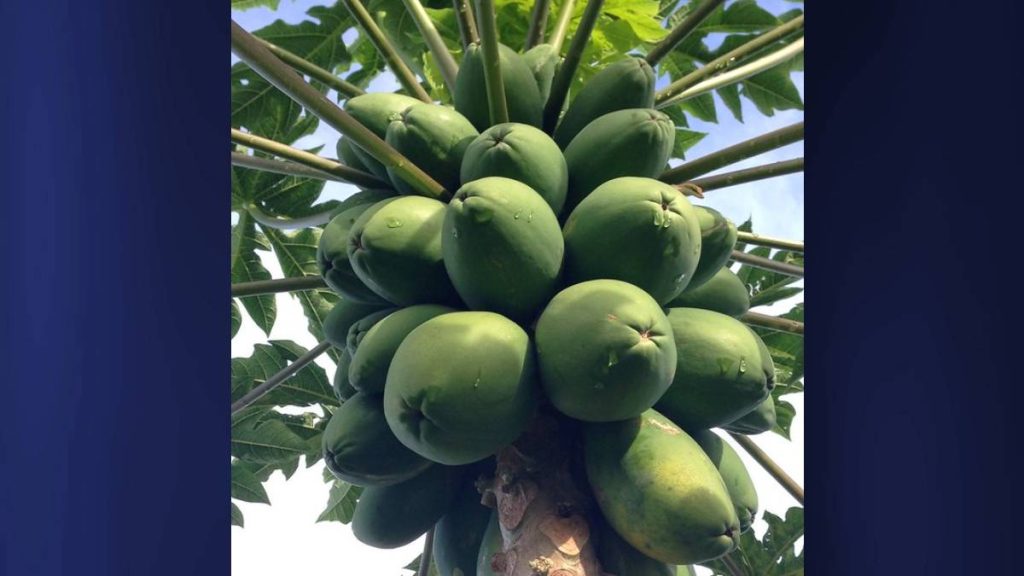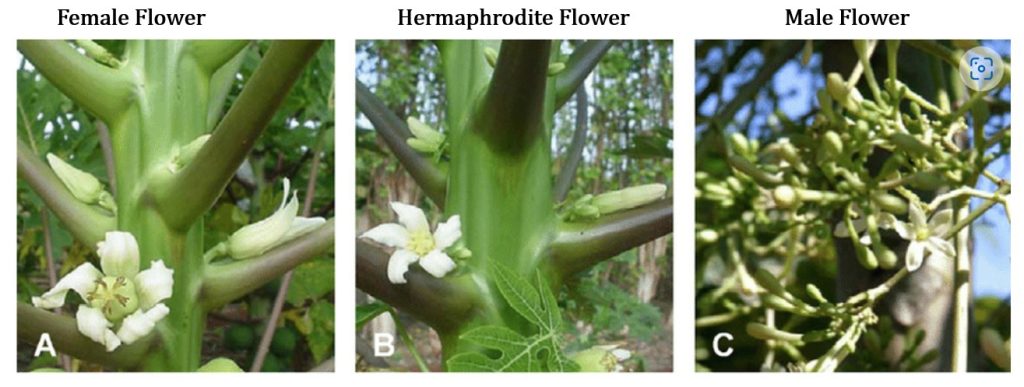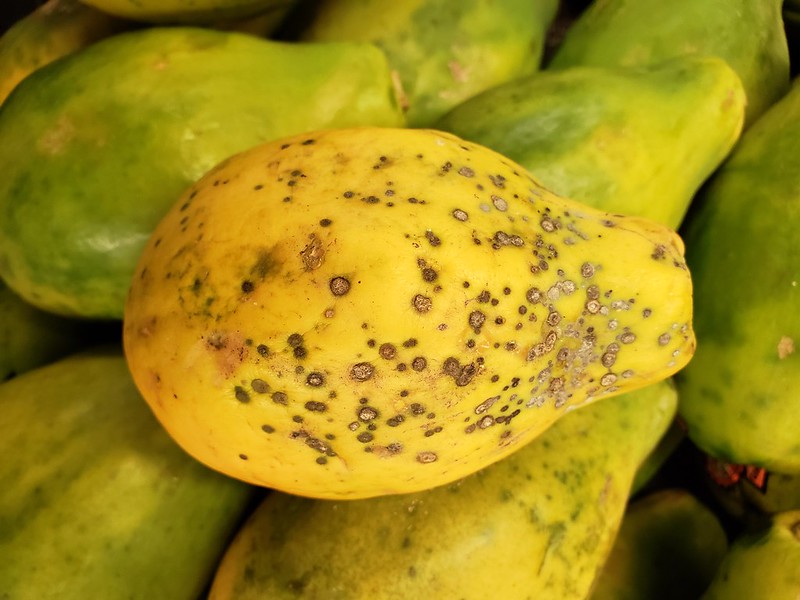Gardening on the Garden Isle: Best to read directions when planting papaya seeds

I was planting papaya seeds when my wife stopped me: “Did you read the directions?”
Flashing my best, 32-tooth smile, I held up the seed packet and told her: “I looked at the picture. You know what they say, ‘A picture is worth a thousand words.’”
I got a withering look as she walked away without a word.
The months passed and the papaya grew. The fruit was small; the leaves were wilted; and taking up permanent residence in my yard were Parrots of Paradise, what I call the green feathered critters that feast on my papaya.
I pulled out the seed packet. My papaya looked nothing like the healthy trees pictured on the packet. As cruel fate would have it, my wife saw me staring at the papaya picture.
“Apparently, your picture was written in a language that you don’t speak. Why don’t you look on the back,” she said as she grabbed the packet and flipped it over. “Well, bless my soul, it is in English and its only 100 words.”
She tapped me authoritatively on the shoulder: “Read them, next time.”
Most gardeners do read the directions. It is just that the all the relevant directions are seldom found in one place. Papaya often seems simple to grow until it isn’t. That is when you find that papaya seems to be a magnet for problems — and many papaya problems are the grower’s fault and can be avoided.
As my wife constantly reminds me, “If you had read and followed the directions, you wouldn’t be dealing with this now.”
So here are the directions I should have read, and some tips, that may help you avoid many papaya problems.
Direction 1. Buy good seeds. The U of H Seed Lab offers three varieties that perform well in Hawaiʻi’s climate. The Sunset, Sunrise and Low-bearing papaya share similar planting, watering, fertilizing and harvesting characteristics. The choice is a matter of taste, size and shelf life.
Direction 2. Papaya requires a lot of sun and fresh air. When planting papaya, leave at least 6 feet between another papaya, building, tree or anything else that restricts light and air flow. A little-known fact about papaya is that it does best below 500 feet elevation. If you want to find the elevation of your property, click the following link https://whatismyelevation.com/. If you are at a higher elevation, you may still be able to grow papaya, but you may experience blossom drop, i.e., the plant flowers and then falls off without setting fruit. If fruit does develop, it is likely to be smaller in size.
Direction 3. I have said this repeatedly, your garden is only as good as your soil. Papaya will grow in most types of soil, but healthy plants and tasty fruit are the product of good soil. A sandy loam mix, rich in organic matter that drains well is best. The papaya plant has a shallow root system. When you plant, prepare the soil horizontally as well as vertically.
Direction 4. Papaya is a water hog. It needs 40 to 60 inches per year. There is no magic formula since soil conditions and rainfall are too variable. Depending on where you live and the papaya variety, you may need to water every day, every couple of days, or never if you live in a rainy area. Papaya does not like too much water. This is why Direction 3 is so important. Leaf and blossom drop is a sign of too much or too little water.

Direction 5. Papaya has three sexual types: female, male and hermaphrodite (both male and female). Male trees have flowers that are on stems that extend from the main trunk of the tree. Female and hermaphrodite trees have flowers that are tight to the main stem. The hermaphrodite plant is the preferred since it has both male and female characteristics in the same flower and will self-pollinate. Most home gardeners remove the male plant.
https://edis.ifas.ufl.edu/publication/MG054
Direction 6. Fertilize regularly once the plant is over a foot tall. Most sources recommend using a balanced fertilizer (14-14-14) every two weeks until the plant is 7 months old, and then fertilize once a month.
Direction 7. Harvest the fruit when the first patch of yellow appears. Pick it and let it finish ripening in the house. In my opinion, this gives a superior taste to the fruit. It also removes the fruit before the fruit flies and the Parrots of Paradise show up for lunch.
Now to the problems you may run into.
Problem 1, You: Most of papaya problems are your own doing or not doing.
Solution: Don’t make me send my wife over, she carries a wet squirrel in her purse. READ the directions. Secondly, most problems are caused by poor sanitation. Clean your tools with a solution of 1-part bleach, 9-parts water and a small drop of soap. When you trim off an infected leaf, clean your tools with bleach water before using it to remove another leaf. A spray bottle is an easy way to apply this to your tools. It adds time but may prevent the spread of disease. Thirdly, do not overwater. Papaya is tolerant, but it does not like extremes. Fourthly, aphids are fond of papaya and are a vector for disease transmission. Treat the plant with Neem Oil at first sign of aphid infestation.
https://www.ctahr.hawaii.edu/oc/freepubs/pdf/papaya_disease_poster.pdf
Problem 2, Powdery Mildew: This is the result of poor air circulation and high humidity.
Solution: You can’t control the humidity but do what you can to improve the air circulation. At the first sign of powdery mildew, remove the infected leaves to prevent spreading. Spray the top and underside of the leaves with Neem Oil. This is an effective treatment that also controls powdery mildew, aphids and white fly.
https://hgic.clemson.edu/factsheet/powdery-mildew/ .
Problem 3, Anthracnose: This is a fungal infection that is damaging to the fruit. The climate of Hawaiʻi is ideal to encourage infection. If you guessed humidity as the main culprit, you would be correct. Spread often is the result of garden tools. The disease often appears as a spot. As the spot grows, it will darken, and the flesh will sink under the spot.
Solution. There are chemical treatments; however, sanitation is usually just as effective. Keep your tools and the area clean. Don’t allow dead leaves to remain on the plant. Harvest the fruit when it starts to ripen, not when it is fully ripe. https://www.ctahr.hawaii.edu/oc/freepubs/pdf/PD-103.pdf
Problem 4. Papaya ringspot virus (PRSV): This is the most serious disease of papaya, caused by a virus that is transmitted by aphids. The symptoms include yellowing with contrasting yellow veins, mottling and distortion of leaves, dark green streaks on stems and leaf stalks, and ring-shaped or C-shaped markings on fruits.
Solution. At the first sign of aphids on the plant, spray with Neem Oil. If the plant is fully infected with PRSV, take a picture, and contact your county extension agent. This disease nearly wiped-out Hawaiʻi’s papaya crop in the 1950s.
https://hdoa.hawaii.gov/pi/files/2013/01/npa02-03_prvmaui.pdf

Problem 5. Black Spot: As the name suggests, black spots will appear on the leaves and the fruits. It is a fungal disease. Initially, small brownish bruises appear on the upper side of leaves that eventually appear on the underside of the leaf as a black spot.
Solution. Proper spacing and airflow are the best way to avoid Black Spot. At first sign of the disease, carefully remove infected leaves and/or fruit to prevent spread of the disease and increase air circulation. Black Spot on the fruit is cosmetic and is safe to consume.
Black Spot of Papaya: How to Recognize and Manage it – UF/IFAS Extension St. Lucie County (ufl.edu)
Problem 6 Phytophthora blight: This is a disease that attacks the roots, stems and fruits of papaya. It usually occurs following extended periods of rain that saturate the soil and starve the plant of oxygen. The symptoms include wilting, yellowing and dying of leaves, dark brown lesions on stems and roots, and soft rotting of fruits. The infected plants may collapse or die.
Solution. Proper soil management improves drainage. Avoid over-watering.
https://www.ctahr.hawaii.edu/oc/freepubs/pdf/PD-53.pdf
I hope this rather dry information wasn’t too painful. It doesn’t cover everything there is to know about papaya. However, it should cover most issues you might encounter as a home gardener. Finally, I am always looking for topics of interest to my readers. If you have a suggestion for a future article, please leave it in the comments box.
Editor’s Note: Every other week, Big Island Now will feature a guest gardening column by Tom Timmons. He is a certified Master Gardener respected for his gardening experience, but his views are not necessarily those of the University of Hawai‘i.
Other gardening columns by Tom Timmons:
Sponsored Content
Notice: Function the_widget was called incorrectly. Widgets need to be registered using
register_widget(), before they can be displayed. Please see Debugging in WordPress for more information. (This message was added in version 4.9.0.) in /mnt/efs/html/wp-includes/functions.php on line 6114




